The image of the big dipper. Constellation Ursa Major - myths and legends of the origin
Big Dipper
Big Dipper \\ Ursa Major - the constellation of the northern hemisphere of the sky. The seven stars of the Big Dipper make up a shape resembling a bucket with a handle. The two brightest stars, Aliot and Dubhe, have a brightness of 1.8 apparent magnitude. For the two extreme stars of this figure (α and β) you can find the Polar Star. The best visibility conditions are in March-April. It can be seen throughout Russia throughout the year (with the exception of the autumn months in southern Russia, when Ursa Major descends low to the horizon). The number of stars brighter than 6.0m - 125.
First classification - Yerkee classification taking into account the luminosity (MKK). An additional factor influencing the shape of the spectrum is the density of the outer layers of the star, depending, in turn, on its mass and density, that is, ultimately, on the luminosity. Especially strongly depend on the luminosities of SrII, BaII, FeII, TiII, which leads to a difference in the spectra of giant stars and dwarfs of the same Harvard spectral classes. The dependence of the type of spectrum on the luminosity is reflected in the newer Yerke classification developed at the Yerkes Observatory by W. Morgan, F. Keenan and E. Kelman, also called the IWC by the initials of its authors. According to this classification, the Harvard spectral class and the luminosity class are attributed to the star: 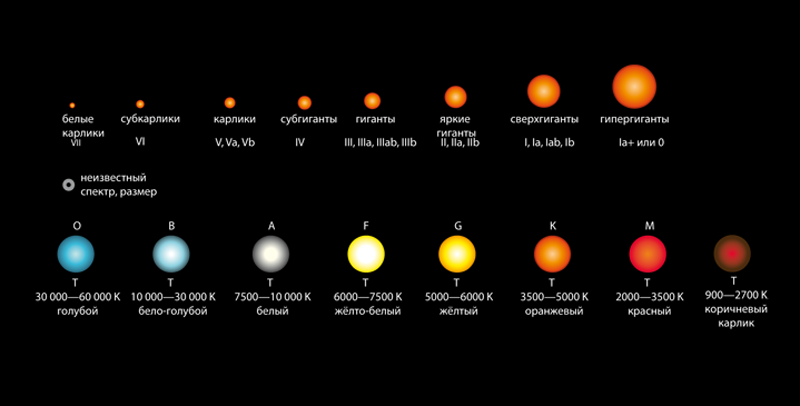
Second classification - Basic (Harvard) Spectral Classificationdeveloped at the Harvard Observatory in 1890-1924 is a temperature classification based on the type and relative intensity of the absorption lines and the emission of stellar spectra. Inside the class of stars are divided into subclasses from 0 (the hottest) to 9 (the coldest). The sun has a spectral class of G2 and an equivalent temperature of the photosphere of 5780 K.
Stars of the constellation Ursa Major
Aliot The Big Dipper Epsilon (ε Ursae Majoris) is the brightest star in the constellation. Located on the 33rd place in brightness among all the stars in the visible part of the sky. Aliot is at a distance of 80.84 light years from Earth. Star - A0pCr - white variable star type α² Hounds Dogs. It has a strong magnetic field (100 times stronger than the Earth's field) splits various elements of the star's hydrogen fuel, then the angle of the axis of rotation to the axis of the magnetic field combines the various elements, sorted by magnetic properties, into a single line visible between Aliot and Earth. The elements react differently with different frequencies of light, refracting it, which is why Aliot can see extremely strange spectral lines, which oscillate over a period of 5.1 days. In the case of Aliot, the axis of rotation and the magnetic field are at an angle of almost 90 degrees to each other. The temperature of the star is 9 400K.
Dubhe (α Ursae Majoris) is the second brightest star. Dubhe is a multiple star, the main component is the orange giant K0III, which is at the stage of burning helium. Her temperature is 6400K. The star is 300 times brighter than the Sun and 15 times larger in diameter. The second F0V and the third F8 star are the main sequence stars. The distance between stars A and B is 23 AU, A and C - 8000 AU. Dubhe is at a distance of about 123.5 sv. years old.
Benetnash This (η Ursae Majoris) is the blue and white star of the main sequence B3 V. Benetnash is already 10 million years old. The star is about 100 sv. years from the sun. Its temperature is 22,000K. It is 6 times the Sun and 1350 times the luminosity.
Mizar - Alcor (ζ UMa) - a system of stars from 6 components. Two stars Mizar A, 2 stars Mizar B and 2 stars Alcor. The main stars are Alcor and Mizar.
Mizar is a dwarf A1V. It is located at a distance of about 78.07 light years. Her temperature is 9000K. Mizar B has a magnitude of 4.0 and spectral class A7, the distance between Mizar A and Mizar B is 380 a. e., the orbital period is several thousand years.
Alcor is the alcor size 4.02, spectral class A5 V. The distance between Mizar and Alcor is more than a quarter of a light year. It is at a distance of 81.06 sv. years old. Its temperature is 8200K.
Merak \\ Beta Ursae Majoris (β Ursae Majoris) - A1V dwarf. 3 times the solar mass and 2 times the radius of the solar. It is 68 times greater than the luminosity of the sun. Temperature - 9400K. It is located at a distance of 79.32 light years (24.4 parsecs).
Thekda \\ Gamma Ursae Majoris (γ Ursae Majoris) - dwarf A0Ve SB. The mass is 2.7 times the solar, as well as the radius is 3 times larger. Its temperature is 9800K. It is at a distance of 83. 55 sv. years (25.5 parsek) It is surrounded by a gas shell. The star rotates very fast, its speed is 178 km / s. Her age is estimated at 300 million years.
Megrets \\ Delta (δ Ursae Majoris) - dwarf A3 V. Megrets 63% more than the mass of the Sun, 1.4 times more than the radius of the Sun. It shines 14 times more and its temperature is 9480K. She has a gas drive for 16 a. e. The star has 2 weak companions.
Tania North \\ Lambda (λ Ursae Majoris) - white A2 A2 subgiant. It is removed at a distance of 134.2 sv. years (42 parsec) from the Earth. She is now 410 million years old. The star has 240% of the mass and 230% of the radius of the sun and emits 37% more. Its temperature is 9100K.
South Tania \\ Mu Ursa Major (μ Ursae Majoris) - red giant M0 IIIab. Its radius is 75 times the size of the sun. Its temperature is about 3700K. The star is on 248.5 St. years old. The star is a semi-correct variable, but after additional observation, the star is considered to have a companion with a period of rotation of 230 days.
Talita North \\ Talitha Borealis (ι Ursae Majoris) - white subgiant A7 IV. It is at a distance of 47.68 sv. years (14.5 parsec). Yota ostoit of three components: Yota of the Big Dipper A, the 9th value of the Yota of the Big Dipper B (M1 V) and the 10th value of the Yota of the Big Dipper C (/ M1 V). These two stars rotate around each other with a period of 39.7 years, and are separated by approximately 0.7 angular seconds. Yota A is 1.7 times more in mass and 1.5 times more in radius of the Sun. Its temperature is 7900K. The luminosity is 9 times greater than the sun.
Talita South \\ Kappa (κ Ursae Majoris) is a double star. Both stars are white dwarfs A0IV-V + A0V. The orbital period of circulation is from 36 to 74 years. These stars are 422.5 light years away. Their temperature is about 9400K. Both stars will become subgiants. Each star rotates more than 201 km / s. (about 3 days). Brightness is 290/250 solar.
Alula North \\ Nu (ν Ursae Majoris) - is a double star. The main star is the orange giant K3 III. Its luminosity is 1355 times larger than the Sun, and its radius is 76 times larger. The temperature is about 4300K. And the mass is 4 times the sun. Stars are removed from us at a distance of 420.9 sv. years old. The second star is the yellow dwarf G1V, whose luminosity is 30% more than the Sun.
Alula South \\ Xi (ξ Ursae Majoris) is a star system. That this dual system was understood by Hives Herschel on May 2, 1780. It was the first visual double star whose orbit was calculated by Felix Savary in 1828. The two stars are the yellow dwarfs G0 Ve / G0 Ve of the main sequence. They are classified as RS Hound Dog variables. The temperature of the stars is ~ 5900 K. Their mass, radius and luminosity are only slightly higher than the sun, and their metallicities are also similar. Each star has a companion. The star Alula Aa is a class M3 companion. Alula Ba’s companion has a brown dwarf or a red dwarf, and even an orange dwarf. In addition, astrometric data indicate the existence of a third partner in this subsystem. The stars are 33.94 light-years away.
Alkafzah \\ Chi (χ Ursae Majoris) - the orange giant K0.5IIIb. It is at a distance of about 195.8 sv. years from Earth. The star is more than 20 times the radius of the sun. Its temperature is 4700K. It shines 172 times stronger than the sun. Its rotation speed is 1.15 km / s. (1000 days). The star is not less than 1000 million years old.
Tien tsan \\ Psi (ψ Ursae Majoris) - the orange giant K1 III. The star is at a distance of 146.7. years from Earth. It is 20 times the radius of the sun. And radiates 148 times. Temperature - 4500K. Rotation around its axis - 1.1 km / s (1 turn in 2.6 years). Tien Tsan began its life 300 million years as the blue-white stars of the main sequence B7 and will end its days as a white dwarf with a mass of about 0.7 times the mass of the Sun.
23 Ursae Majoris - yellow subgiant F0IV. It is at a distance of 75.41 sv. years old. Her tempera is 7300K. It shines 14 times the size of the Sun and 2.5 times the radius. Rotational speed - 147 km / s (1 turn - 20.4 hours). A star is a Delta Shield type variable. She has a satellite orange dwarf K7v. Mass 0.63 solar.
Muscida \\ Omicron (ο Ursae Majoris) - the yellow giant G4 II – III. It is at a distance of about 183.4 sv. years old. Its mass is about 2.42 the mass of the sun. Radius is 14 times larger than Solar. Radiates at 138 times more. Its temperature is 5282K. The star has a companion - the red dwarf M1v, which is the X-ray source.
Upsilon (υ Ursae Majoris) is a double star. The main component of the yellow subgiant is F2 IV. This variable Delta Shield type star. The rotation speed of 124 km / s. (1.4 days). Its temperature is 7300 K. Luminosity is 30 times more than the Sun. The star has a satellite - red dwarf M0V. With a mass of about 5 solar. Stars are at a distance of 114.9 sv. years from Earth.
φ Ursa Major - subgiant A3IV. It is at a distance of about 436.1 of sv. years old. Her temperature is 8900K. 2.5 times the mass of the sun.
Theta (θ Ursae Majoris) is a binary system of stars. The main star is the yellow subgiant F6 IV. They are located at a distance of 43.93 sv. years from Earth. It is more than the Sun by 141% and 250% more in radius. She is already 2.2 billion years old. Its temperature is 6500K. The Mac-Donald Observatory assumes that the star has planets with a mass between 0.24 and 4.6 masses of Jupiter and an orbit between 0.05 and 5.2 AU.
Objects of deep space in the constellation Ursa Major
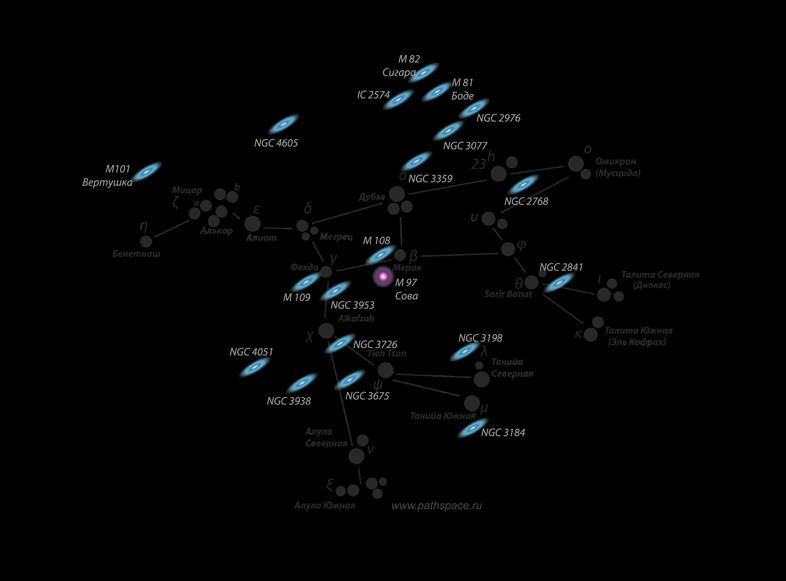
Nebulae
M 97 - Owl Nebula - Planetary Nebula. The first discoverer - Pierre Meschen. 16.02. 1781 The nebula is located at a distance of 2598 sv. years from us. Photographic magnitude (B) - 12.0. Visible dimensions 3.4 "× 3.3". The nebula is a cylindrical light ring. The Owl Nebula was formed 6000 years ago. The central star now has a mass of 0.7 solar masses and a magnitude of 16. To see the nebula well, you need a telescope from 150 to 200 mm. Size across - 2.2 of sv. of the year.
Galaxies
Galaxy Cigar \\ M82 - Wrong galaxy with powerful star formation. Type I0 edge-on. Increased star formation is probably caused by the gravitational interaction of the Galaxy Bode, this interaction began about 100 million years. Because of the gravitational interaction, it is believed that it became irregular. In the infrared study, distorted spiral arms were found. Star formation has lasted for 50 million years. The Hubble telescope detected 197 star clusters in the galaxy. The frequency of supernova explosions is once every 10 years. In the center is a black hole 30 million times the mass of the sun. And it also revealed the existence of small black holes with a mass of 500 times the mass of the Sun. Most of the stars in the galaxy were born 500 million years ago. The galaxy is at a distance of 12.09 million light years. Redshift - 203 ± 4 km / s. Visible dimensions - 11`.2 × 4`.3. Size across - 39420 s. years old.
Galaxy Bode- M81 - spiral galaxy Sb. The first discoverer Johann Bode in 1774 Large infrared radiation emanates from cosmic dust in the spiral arms of the galaxy due to star formation. In 1993, a type IIb supernova broke out in the galaxy. The galaxy is at a distance of 11.7 million. years (3.6 parsecs). The galaxy contains about 250 billion stars, less than in the Milky Way. The Bode Galaxy is in gravitational interaction with the spiral galaxy NGC 3077. This influence separates the hydrogen layer from 3 galaxies (M81, M82 and NGC 3077) and leads to star formation in the centers of galaxies. Galaxies M81, M82 are visible in a telescope from 75 mm. To distinguish the details, you need a telescope with an aperture of 20 cm. The galaxy is at a distance of 12 mil St. years old. Visible dimensions are 24.9 "× 11.5". Photographic magnitude mB 7.8. The redshift is −0,000140 ± 0.000040. Size across - 86 980 over. years old.
Galaxy Pinwheel - M 101 - spiral galaxy SA (sr) c. The first discoverer - Pierre Meschen 03.27.1781 The spinning wheel galaxy is very similar to the Milky Way: pronounced spiral arms and a small compact bulge. But "Pinwheel" is larger than the "Milky Way" in size. Its diameter - 206 000 of St. years old. Previously, the Whirlpool galaxy experienced collisions with other galaxies, which follows from some asymmetry. In this galaxy on August 24, 2011 a Type Ia supernova blew out. This was the fourth supernova seen from Earth. Were still in 1909, 1951. and 1970. The galaxy is 24.57 million sv. years old. (8 megaparsek). Visible dimensions are 27 "× 26". Photographic magnitude mB 8.2. The redshift is 0.0013 ± 0.0002. The galaxy can be observed in a telescope with a diameter of 50 mm. With good conditions and a telescope diameter of 150mm, you can dispel the details: the stars and spiral arms.
M 108 - a spiral galaxy with a jumper (Sc). It was discovered by Pierre Meschen on 02/16/1781. The galaxy is almost visible from the edge. This galaxy has a mass of about 125 billion solar masses. And includes 290 ± 80 globular clusters. With the help of the Chandra X-ray Observatory, 83 X-ray sources were found. At the center is a supermassive black hole equal to 24 million times the mass of the sun. Photographic magnitude mB 10.6. Red shift +0.002328 ± 0.000003. The galaxy is at a distance of 44.97 million sv. years from us. Size across - 112 000 of St. years old.
m 109 - spiral galaxy with a jumper SB (rs) bc. It is located at a distance of 54.96 million light-years from Earth and moves away at 1142 km / s. The first discoverer - Pierre Meschen 04.04.1781. The galaxy has 3 satellites: galaxies UGC 6923, UGC 6940 and UGC 6969, possibly more. In March 1956 in the galaxy m 109 a supernova broke out Ia. Photographic magnitude mB 10.6. Red shift +0.003496 ± 0.000010. Size in diameter - 120 000 sv. years old.
NGC 2768 - elliptical galaxy (E6). The first discoverer, William Herschel 19.04. 1790 Red shift +0.004590 ± 0.000250. The speed is (+1373 ± 5) km / s. Photographic magnitude mB 10.9. Is at a distance of 62.89 million sv. years from Earth. Size across - 117 200 of St. years old.
NGC 2841 - spiral galaxy (Sb). The first discoverer - William Herschel 03/09/1788g. It is at a distance of 51.5 million sv. years from Earth. Red shift +0.002121 ± 0.000003. Photographic magnitude mB 10.1. Visible dimensions 8.1 "× 3.5". Size across - 121 400 of St. years old.
NGC 2976 - spiral galaxy Sc / P. The first discoverer - William Herschel November 8, 1801. The galaxy will contain many dark streaks and star clusters closer to the disk. It has no clear spiral arms due to the gravitational interaction with neighboring galaxies M81 and M82. Photographic magnitude mB 10.8. Red shift +0.000040 ± 0.000070. It is at a distance of 11.99 million sv. years from Earth. Size across - 20,600 of sv. years old.
NGC 3077 - spiral galaxy (Sd). The first discoverer - William Herschel 08.11.1801g. The galaxy has an active core. The galaxy is at a distance of 12.96 million sv. years old. Photographic magnitude mB 10.6 Visible dimensions 5.2 "× 4.7" Red shift +0.000040 ± 0.000013. Size across - 19 600 of St. years old.
NGC 3184 - jumper spiral galaxy (SBc). The first discoverer William Herschel 03/18/1787. The galaxy is at a distance of about 36.84 million sv. years from Earth. NGC 3184 has a high content of heavy elements. In 1999, a type II supernova broke out in this galaxy; In addition, NGC 3184 has a high content of heavy metals. Red shift 0.001975. Size across - 79,400 of sv. years old.
NGC 3198 - jumper spiral galaxy (SBc). The first discoverer, William Herschel 15.01.1788g. Visible dimensions 8.5 "× 3.3" The photographic magnitude mB 10.9. It is at a distance of 47.93 million sv. years old. Size across - 118 600 of St. years old.
NGC 3359 - jumper spiral galaxy (SBc). The first discoverer William Herschel 28.11.1793g. Visible dimensions 7.2 "× 4.4" Photographic magnitude mB 11.0 Red offset +0.003376 ± 0.000007. It is at a distance of 42.38 million sv. years old. from the earth. Size across - 88,800 sv. years old.
NGC 3675 - spiral galaxy (Sb). The first discoverer - William Herschel 1/14/1788g. Visible dimensions 5.9 "× 3.1" Photographic magnitude mB 10.8. Red shift +0.002542 ± 0.000033. It is at a distance of 67.97 million sv. years from Earth. Size across - 116,800 of sv. years old.
NGC 3726 - jumper spiral galaxy (SBc). The first discoverer William Herschel 05.02.1788g. Visible dimensions 6.0 "× 4.1" Photographic magnitude mB 10.9 Red shift +0.002872 ± 0.000027
NGC 3938 - spiral galaxy (Sc). In the galaxy, outbreaks of three supernovae were registered: SN 1961U, SN 1964L and SN 2005ay. The number of objects registered in NGC 3938 is 164 objects. The galaxy is at a distance of about 43 million sv. years from Earth. Visible dimensions 5.4 "× 4.9" Photographic magnitude mB 10.8
NGC 3953 - spiral galaxy SBbc. The first discoverer William Herschel 04.04.1789g. In the galaxy, outbreaks of two supernovae were recorded: SN 2001dp and SN 2006bp. Visible dimensions 6.9 "× 3.6" Photographic magnitude mB 10.6 Red shift +0.003509 ± 0.000027
NGC 4051 - spiral galaxy SBbc. The first discoverer William Herschel 06.02.1788g. The center of the spiral galaxy NGC 4051 is a supermassive black hole that ejects from 2 to 5 percent of the matter accreting to it. Visible dimensions 5.2 "× 3.9" Photographic magnitude mB 10.8. Redshift +0.002336
NGC 4605 - spiral galaxy SBc / P. The first discoverer, William Herschel 04.04.1790g. Visible dimensions 5.9 "× 2.4" Photographic magnitude mB 10.8 Red shift +0,000484 ± 0,000020. It is located at a distance of 17.59 million of sv. years from Earth. Size across - 30 200 of St. years old.
IC 2574 (Coddington Nebula) is a dwarf irregular galaxy. She has 2 sleeves of irregular shape. The galaxy is 2 times smaller than the Milky Way. The first discoverer of Edward Foster Coddington in 1898. 90% in the galaxy is dark matter. The galaxy is at a distance of 11.76 million sv. years old. Visible dimensions are 12.3 "× 5.9". Size across - 44,040 over. years old
The constellation of this month is familiar to any resident of the Northern Hemisphere. Throughout its history, Ursa Major was an easily recognizable figure in the night sky. She seemed now to be a bear, now a plow, and three hunters with a bear and a bear with a cart were recognized in it. (I did not forget to mention that she looked like a bear? :-) In asterism - the Big Bucket - they guess, probably, the greatest number of figures for the night sky. The bucket serves as a guideline to search for many of the constellations of the Northern Hemisphere, and is itself an open cluster. It is denoted as Collinder 285, or the moving group of stars of the Big Dipper, includes five central stars of the Bucket and is located only 70 light years from Earth. Cr285 is best viewed with the naked eye.
| Title | Type of | The size | Sound led | |
| Objects | NGC 2841 | Galaxy | 8.1 "x3.5" | 9,3 |
| NGC 2976 | Galaxy | 5.9 "x2.7" | 10,1 | |
| M 81 | Galaxy | 24.9 "x11.5" | 7 | |
| M 82 | Galaxy | 11.2 "x4.3" | 8,6 | |
| NGC 3077 | Galaxy | 5.2 "x4.7" | 10 | |
| IC 2574 | Galaxy | 13.2 "x5.4" | 10,2 | |
| M 108 | Galaxy | 8.6 "x2.4" | 9,9 | |
| M 97 | Planetary nebula | 2,8 | 9,9 | |
| NGC 3718 | Galaxy | 8.1 "x4" | 10,6 | |
| NGC 3729 | Galaxy | 2.9 "x1.9" | 11 | |
| NGC 3953 | Galaxy | 6.9 "x3.6" | 9,8 | |
| M 109 | Galaxy | 7.5x4.4 | 9,8 | |
| Cr 285 | Cluster of stars | 1400" | 0,4 | |
| M 101 | Galaxy | 28.8 "x26.9" | 7,5 | |
| NGC 5474 | Galaxy | 4.7 "x4.7" | 10,6 | |
| Complex objects | Hickson 56 | Galaxy cluster | 14,5 | |
| Hickson 41 | Galaxy cluster | 13,9 |
In the Big Dipper (BM) there are several famous stars outside the Bucket. It contains Lalande 21185 - a red dwarf with a magnitude of 7.49, which is the fourth star in proximity to the solar system and is located only 8.1 light years. Lalande 21185 is the brightest red dwarf that can be seen in the Northern Hemisphere. BM sheltered the star of Groombridge 1830 with a brilliance of 6.45, which is 28 light years from us and moves at the third highest speed among all known stars. Groombridge 1830 belongs to the class of stars II, and its age is not less than that of many globular clusters. Another famous star in Ursa Major - 47 Great Bears, which is one of many sun-like stars and may have inhabited planets.
Ursa Major has a total of 7 Messier objects, 6 of which are of visual interest. (We will drop the M40, although observers of binary stars may want to look at it.)
The first superdeep Hubble shot, Hubble Deep Field: 12: 36: 49.4000s + 62d 12 "58.000" was taken in Ursa Major. This tiny window (like a grain of rice from an arm's length) allowed the Hubble telescope to look beyond our galaxy and catch at least 1,500 galaxies with a 10-day exposure. Almost everything you see in the image below is a galaxy. (If you have high-speed Internet, be sure to look at the "Enlarged Image of the Hubble Deep Field".)
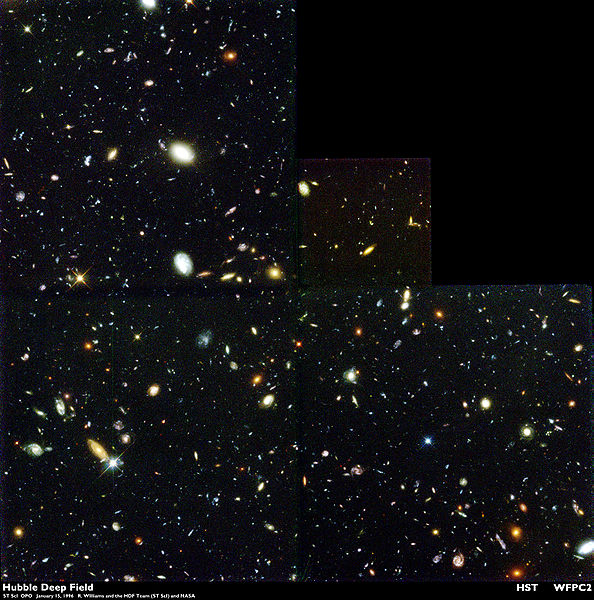
Before we go any further, let's take a closer look at the stars that make up the Bucket. If you start with the handle, here is Alkaid, then on the bend of the handle - the Alcor and Mizar are visible with the naked eye. Going down the bucket below, we get to Aliot, and a little further we find the first of the stars of the actual bucket - Megrets. Below we stumble first on Thekda, then Merak and Dubhe. One of the first things that any newcomer learns is to draw a line through Merak and Dubha to find the North Star, the northern star of Ursa Minor.
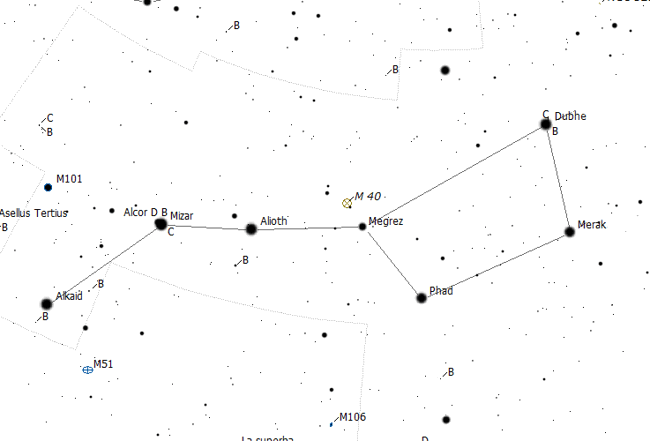 I read in different sources that many civilizations and cultures use Alcor and Mizar as a test for visual acuity, but it puzzles me a little, since I myself have never had a hard time separating them.
Frankly speaking, Ursa Major is a frightening constellation in terms of writing a guide on it: it is gigantic and contains a dozen targets, even for an observer with the most modest telescope. So I focused on those objects that I myself consider the brightest and most exciting. But I left one area aside - Walter Scott Houston called it "the cup of the night" - directly the bowl of the Bucket. After passing this month's tour, I recommend you spend some time and look through the area inside the bowl: several targets are suitable for an average telescope. I will provide you with a search map, and at the end of the article you will find a list of bright galaxies inside and around the bowl.
I read in different sources that many civilizations and cultures use Alcor and Mizar as a test for visual acuity, but it puzzles me a little, since I myself have never had a hard time separating them.
Frankly speaking, Ursa Major is a frightening constellation in terms of writing a guide on it: it is gigantic and contains a dozen targets, even for an observer with the most modest telescope. So I focused on those objects that I myself consider the brightest and most exciting. But I left one area aside - Walter Scott Houston called it "the cup of the night" - directly the bowl of the Bucket. After passing this month's tour, I recommend you spend some time and look through the area inside the bowl: several targets are suitable for an average telescope. I will provide you with a search map, and at the end of the article you will find a list of bright galaxies inside and around the bowl.
 We will start the evening tour at the bottom of the bowl, on the line between Fekda and Merak. Exactly southeast of Fekda (the stars on the far side of the bottom that are closer to the hilt), we will find Messier’s first target for today: M 109.
We will start the evening tour at the bottom of the bowl, on the line between Fekda and Merak. Exactly southeast of Fekda (the stars on the far side of the bottom that are closer to the hilt), we will find Messier’s first target for today: M 109.
Discovered by Meshen M 109 Messier was known, but did not appear in "his" list until the middle of the 20th century. Messier’s original list consisted of 103 targets, including a few dubious ones (M40 is a double star, and the “missing” Messier is M 102).
 M 109 Photographer Jason Blaschka
M 109 Photographer Jason Blaschka
The picture taken by Jason Blaschka M 109 is striking, but not very similar to what I see even in the largest telescopes. Several features: even in a 4-inch apochromat (under a good sky), the galaxy has a noticeable resemblance to a fighter from Star Wars (TIE-fighter) - the central jumper is often visible, but on rare nights I can catch a hint of spiral sleeves in a small aperture.
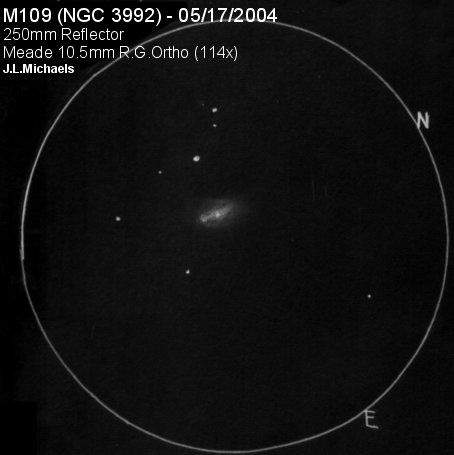
Jay Michaels made an excellent sketch — a great example of what can be seen in an 8–10-inch telescope on a good night. While you're here, take some time searching. NGC 3953, about a degree south of M 109. Then move to the middle of the bowl bottom, go down a little to the south and find a pleasant cluster of objects - NGC 3718,NGC 3729 and one of the complex objects of this month Hickson 56.
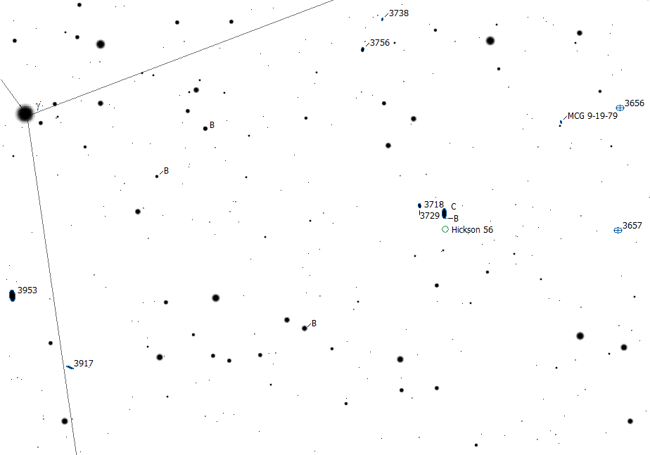

With an average increase of 3718 and 3729 are in the same field of view. I would say that 3718 is about three times more than 3729, but in my opinion, galaxies are quite similar to each other. In large telescopes, I see that both have noticeable (albeit weakly) nuclei, and scattered external halos. A little further south you will find Hickson 56 - but we will return to it later.
Move to the star at the base of the bucket (Meraku) with a wide-angle eyepiece at low magnification, and you stumble upon a random sky pair. First, the field will be M97 - owl Nebula, a planetary nebula discovered by Pierre Meschen in 1781. I believe that this is one of the few objects that actually resemble their nickname. Even in a small telescope (under good conditions) I can catch a glimpse of the outlines of dark spots - owl eyes. The nebula is quite large, so its surface gloss is rather low. Some observers claim that they have seen blue or green on the surface of the disk. On an excellent observant night, I caught the shades of green in a large telescope, but usually the disk looks just gray.
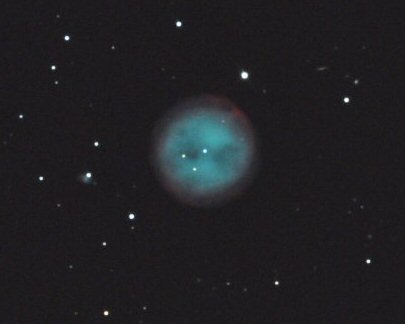
The M97 shot by Rick Krejecki is amazing. Take a look at the high resolution version on his website (http://www.ricksastro.com/DSOs/owl_XT_xscope.shtml) - you can spend a lot of time just counting tiny background galaxies. I wonder if at least one of them was visually identified by observers with giant telescopes?
If you have a desire to look at non-galactic targets, you will not have to go far - a little closer to Meraku you will find a spiral galaxy M 108located edge to us. Experiment a little with different magnifications - see if you can discern the mosaic structure and if you can detect at least some external halo presence.
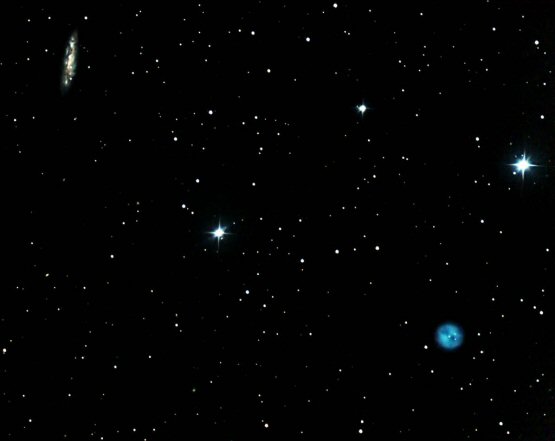
An excellent shot of Tom Nicolades in one frame shows the shattered and swaying M 108 and M 97 electrician colors. With a low magnification of a wide-angle eyepiece (the field of view of the telescope + eyepiece system, TFOV, must be greater than 1 degree), both objects can be easily caught in the same field of view.
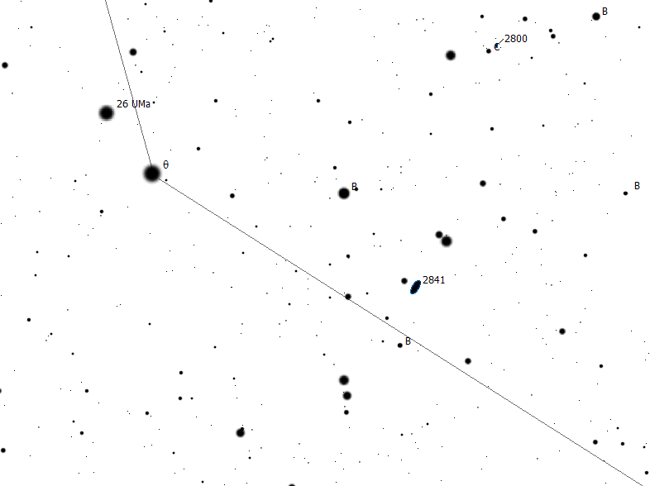
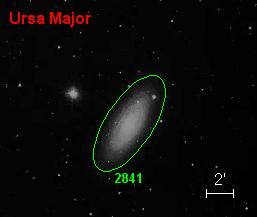
While we are here, let's jump over the front legs of the Bear and take a quick look at NGC 2841. This galaxy with shine 9.2 is like a ray of hope for medium-sized telescopes. The bright core region is surrounded by a slightly dimmer halo. If you have a large telescope, look for a strip of dust, i.e. sharp halo attenuation on one side of the galaxy.
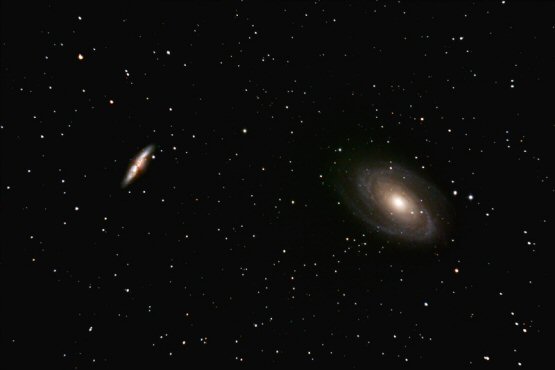 M 81 / M 82 - Photographer John Moody
M 81 / M 82 - Photographer John Moody
Having finished with 2841, we move on to a pair of real pearls of Ursa Major, M 81 and M 82.
M 81 and 82 make up an exciting pair of galaxies, which can be seen even with small binoculars. They are separated by only 3/4 degrees, are visible in wide-angle eyepieces and are a wonderful pair. They were discovered by Bode in 1774 and are an illustration of galactic morphology, which at first glance does not allow for large differences. Both galaxies are members of a small cluster of galaxies called the M 81 group (which is located nearby, 10 million light years), so it would be appropriate to discuss M 81 first. In small telescopes, M 81 is a bright oval, but large telescopes start to show it spiral structure. Of these two, the M 81 is definitely bigger and brighter, and in long exposure photos it looks like a classic spiral galaxy. M 82, in contrast to it, is twisted incorrectly and looks as if it had failed in some huge celestial conflict. In the 18-inch telescope, I see it curved at one end, the spotting is clearly distinguished, as well as the almost clear partition about a third of the way from one of the edges. It is a little dimmer than the M 81, but visually I find it to be much more impressive.
 It is worth noting that this is one of the few DSOs in which visuals see color, but so far not even in 80-mm telescopes. My friend in Arizona, who has access to a 30-inch telescope, describes that he saw a red or pink color, and I do not see anything like it, although I observe this object with telescopes up to 25 ”in diameter. I think that this will require excellent night, good optics and the maximum aperture that you can afford.
But do not despair! In my opinion, the M 82 is one of the most beautiful targets in the night sky, be it with or without color. Even in small telescopes, this pair is stunning, and it can be distinguished in the dark sky with minimal help from optics.
It is worth noting that this is one of the few DSOs in which visuals see color, but so far not even in 80-mm telescopes. My friend in Arizona, who has access to a 30-inch telescope, describes that he saw a red or pink color, and I do not see anything like it, although I observe this object with telescopes up to 25 ”in diameter. I think that this will require excellent night, good optics and the maximum aperture that you can afford.
But do not despair! In my opinion, the M 82 is one of the most beautiful targets in the night sky, be it with or without color. Even in small telescopes, this pair is stunning, and it can be distinguished in the dark sky with minimal help from optics.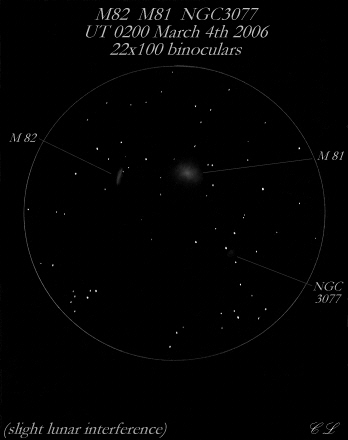
A sketching of this area by Carol Lakomiak gives you a great idea of what you can see with large binoculars or a small telescope.
As you can see from the map, there are many other goals in this region. Allocate a little time and scout all around - follow the NGC 3077, 2976 and IC 2574. In my opinion, NGC 3077 and 2976 in large telescopes are similar in magnitude to M 81 in small apertures. If in search of M81 to use the "star trail method" and linger on one of them, it can be embarrassing. Your expectations should always meet the aperture.
We didn’t even begin to really uncover the possibilities of Ursa Major, and yet we will make another stop, and then we will move on to two complex objects.
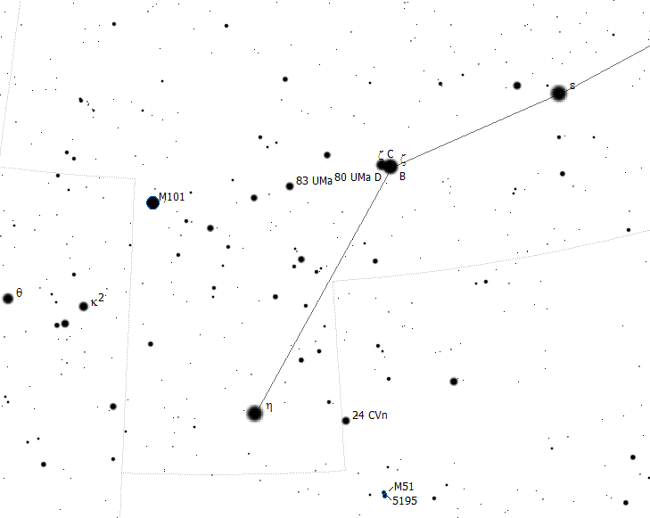 Round the top of the bucket and continue to move away from the handle to find M 101 - galaxy Pinwheel (Pinwheel) *. It was discovered by Meshen in 1781 and in a large telescope looks really spectacular, showing obvious spiral structure and spotting in the sleeves.
Round the top of the bucket and continue to move away from the handle to find M 101 - galaxy Pinwheel (Pinwheel) *. It was discovered by Meshen in 1781 and in a large telescope looks really spectacular, showing obvious spiral structure and spotting in the sleeves.The M101 has a large, loose surface that can be misleading and complicate its observation with a small telescope. Remember, when you look for this large object: its size is about 2/3 of the Moon at full moon, but the surface gloss is very low, so be careful and gradually separate it from the background. The galaxy is huge - reference books point from 170,000 to 190,000 light years across. The distance to it is about 25 million light-years, and it includes some of the most exciting and vast known areas of star formation.
Many of these star hospitals are bright enough to earn their own NGC numbers: NGC 5441, 5447, 5450, 5449, 5451, 5453, 5458, 5461, 5462 and 5471.
NGC 5471 - the largest and brightest HII area in M101, much more than anything comparable in the Milky Way (it is assumed that 5471B contains a hypernova star). It is visible in large telescopes, and despite the fact that I often recommend viewing galaxies at high magnification (my favorite “galactic horse” - the Nagler 13t6 eyepiece and Obsession 18 ”telescope - provides an magnification of about 180x and a good wide field of view), the detailed structure of M101 I would rather advise to search at high and low magnifications and decide what works best for you personally. Be sure to take a look at the brightest areas of HII. Please note that the image below does not capture 5450 and 5447 - 5447 is located south of 5450.
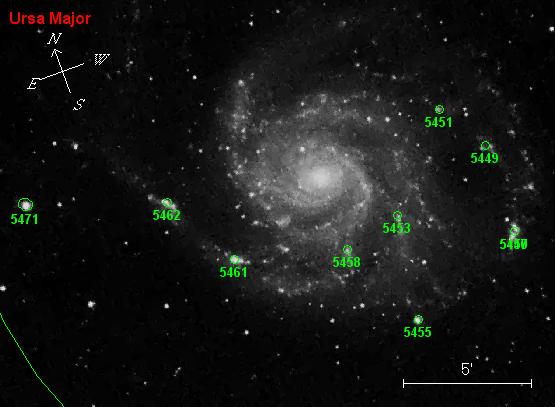 Region HII. Galaxy M 101
Like M81, M101 is the main member of the galaxy group of the same name, so while you are in this area, carefully follow the other robbers. The brightest are NGC 5474 and NGC 5473, but there are many others here.
Region HII. Galaxy M 101
Like M81, M101 is the main member of the galaxy group of the same name, so while you are in this area, carefully follow the other robbers. The brightest are NGC 5474 and NGC 5473, but there are many others here.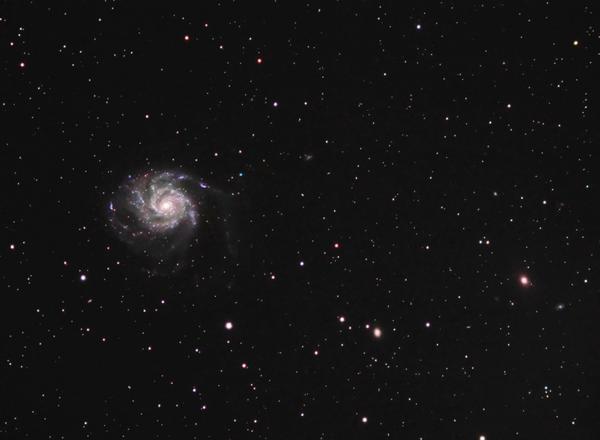 M101. Photographer James Jacobson
M101. Photographer James Jacobson
Complex objects In the Big Dipper there are several objects worthy of being called complex. The first thing that comes to mind is the 7 Hickson groups, the Palomar 4 globular cluster and the rather bright quasar. Quasars are interesting by themselves, not by what you see in the eyepiece, but with Palomar 4, of course, you can cope with a large telescope and in a dark area, so in general, I tend to a group of galaxies. Considering the above, I represent as complex objects the two "brightest" Hickson in the Big Dipper: Hickson 56 and Hickson 41.
Hickson 56 is exactly south of a pair of galaxies that we visited earlier - NGC 3729 and 3718.

Notice that the marker that marks the position of the Hickson 56 is slightly offset in the image above. Hickson 56 includes 5 components (although not all of them can be seen), whose brilliance varies from 16.2 to 15.8, and they are all tiny (the largest takes 1.3x2 arc-seconds), so be sure to take them for good conditions and with a large aperture.
Iiro Sairanen from Finland observed Hickson 56 with a 16-inch Newton at 292x and provided the following sketch:
 Another complex object of the month - Hickson 41.
Hickson 41 is a bit harder to get to, but a bit brighter. Again, note that it does not ideally match the given maps. Rely on DSS images. There are 4 components with a magnitude of 14.6 to 18.1, where the largest element is just 1.5x2 angular seconds in size. Alvin Huey, observing at 377x and 528x, wrote in his excellent observation guide for the Hickson groups (“Hickson Group Observer’s Guide”) that he had failed to catch the fourth member of the Dobson 22 ”f4.1 group.
Another complex object of the month - Hickson 41.
Hickson 41 is a bit harder to get to, but a bit brighter. Again, note that it does not ideally match the given maps. Rely on DSS images. There are 4 components with a magnitude of 14.6 to 18.1, where the largest element is just 1.5x2 angular seconds in size. Alvin Huey, observing at 377x and 528x, wrote in his excellent observation guide for the Hickson groups (“Hickson Group Observer’s Guide”) that he had failed to catch the fourth member of the Dobson 22 ”f4.1 group.
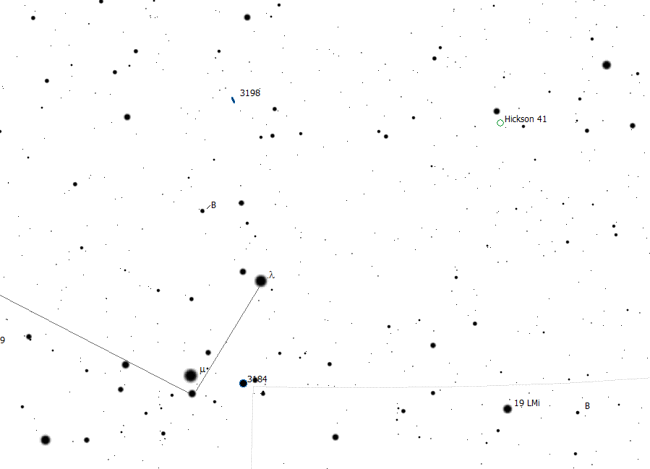
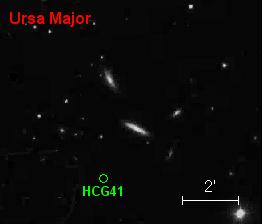
I was able to catch three of these four galaxies with the help of 18 ”f4.5 from my driveway, but it required some tricks - it took a good evening, I covered my head with a towel to get rid of the stray light, and used very large increases (600x) To sufficiently darken the background of the sky. Finally, I had to resort to tapping on a telescope to make sure that I spotted all three members of the group. Hicksons, for the most part, are not random observations or objects for a quick glance. To take a look at these tiny groups of interacting galaxies, use every trick in the book, including high magnification and perseverance. Additional Goals
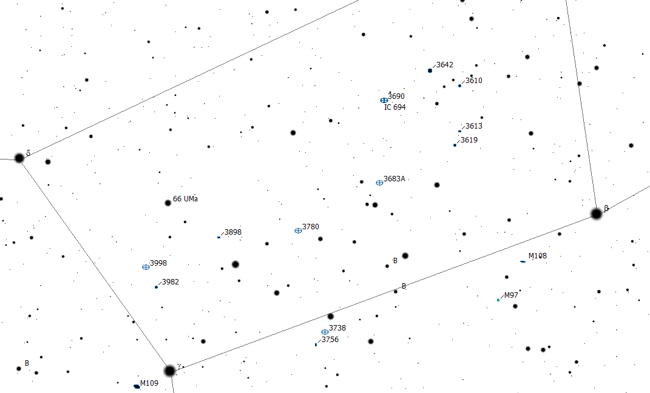 As I wrote above, Walter Scott Houston called this area "the cup of the night." Here is a map that can give you a few more reasons for traveling around the bucket.
And this is the necessary information about additional purposes:
As I wrote above, Walter Scott Houston called this area "the cup of the night." Here is a map that can give you a few more reasons for traveling around the bucket.
And this is the necessary information about additional purposes:
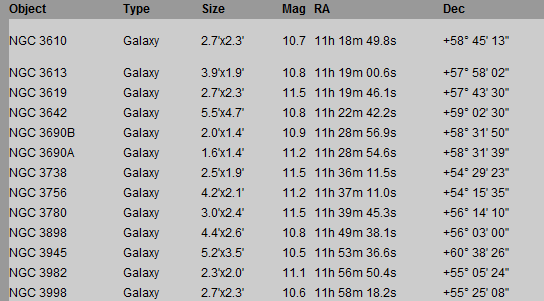
* Help from Wikipedia: Russian name Tsevochnoy Wheel - the result of an incorrect translation from English. The pinwheel used in gears, resembles a squirrelling wheel of two parallel rims connected by pins; in English, the pinwheel, and the pinwheel (breeze) (a children's toy, a multi-blade impeller mounted on an axis (pin) and unwound by the wind) are denoted by the term pinwheel, but in appearance the galaxy with its spiral arms looks like a spinner rather than pinwheel.
Until new meetings,
Tom T.
Probably, every adult person remembers a wonderful lullaby song from an old Soviet cartoon about Umka. It was she who first showed the little Ursa constellation to small television viewers. Thanks to this cartoon, many had an interest in astronomy, and wanted to find out more about this so strangely named set of bright planets.
The Great Bear constellation is the asterism of the northern hemisphere of the sky, which has a huge number of names that have come down to us from antiquity: Elk, Plow, Seven Sages, Carriage and others. This set of bright celestial bodies is the third largest pleiad of the whole sky. The most interesting thing is that some parts of the “ladle” entering the constellation Ursa Major are visible all year round.
Due to its characteristic location and brightness, this pleiad is well recognizable. The constellation consists of seven stars that have Arabic names, but Greek designations.
Stars entering the constellation Ursa Major
Designation | Title | Interpretation |
Loin |
||
Start of tail |
||
Origin not known |
||
Loincloth |
||
Benetnash (Alkaid) | Leader of the mourners |
There is a huge variety of theories about the emergence of the Big Dipper constellation.

The first legend is associated with Eden. A long time ago, the nymph Callisto, the daughter of Lycaon and the assistant goddess Artemis, lived in the world. There were legends about her beauty. Even Zeus himself could not resist her charms. The union of god and nymph led to the birth of a son Arkas. Angry, Hera turned Callisto into a bear. During one of the hunts, Arkas almost killed his mother, but Zeus saved her in time by sending him to heaven. He also moved his son there, turning him into the constellation Ursa Minor.
The second legend is directly related to Zeus. According to legend, the ancient Greek titan Kronos destroyed each of his heirs, because it was predicted that one of them would overthrow him from the throne. However, Rhea - the mother of Zeus - decided to save the life of her child and hid him in the Ida cave, located on the modern island of Crete. It was in this cave that the goat Amalfei and two nymphs were fed, according to legend, former bears. Their names were Gelis and Melissa. Having overthrown his father and the rest of the titans, Zeus presented his brothers, Aida and Poseidon, with an underground and water kingdom, respectively. In gratitude for the feeding and care, Zeus immortalized bears and a goat, bringing them to the sky. Amalthea became a star in A. Gelis and Melissa are now two galaxies - the Big Dipper and the Little Dipper.

The myths of the Mongolian peoples identify this asterism with the mystical number "seven." They have long been called the Great Bear constellation, the Seven Elders, the Seven Sages, the Seven Kuznetsov and the Seven Gods.
There is a Tibetan legend of the appearance of this galaxy of bright stars. It is believed that once upon a time a man with a head of a cow lived in the steppes. In the fight against evil (in the tradition it appears as a black bull), he stood up for the white bull (good). For this the man was punished by the witch, having struck with an iron instrument. From blow it broke up into 7 parts. Good white bull, appreciating the contribution of man in the fight against evil, lifted him to heaven. So the constellation Ursa Major appeared, in which there are seven bright stars.
Deep shot of the Big Dipper constellation
The Big Dipper constellation is one of the largest constellations in the area, the third after Hydra and Virgo. More than 200 stars belong to this part of the sky, and up to 125 of them can be distinguished with the naked eye, on a moonless night far beyond the city.
However, the constellation Ursa Major became the most recognizable thanks to a group of seven stars that form the so-called. Big Bucket. Such conspicuous groups of stars are called "asterism."
Various names
Since initially this region of the sky was associated in humans only with the Big Dipper asterism, most of the existing names were relevant:
- The ancient Greeks called the constellation "Gelika", which means "shell", sometimes "Arktos" - "bear" or "bear". According to some Greek authors, Ursa Major served the ancient Greeks as a navigator. According to the Greek myth, Zeus turned two Cretan nymphs into bears with the aim of hiding from Kronos. According to another version - the nymph Callisto, to hide from his sister and wife - Hera.
- The Indian (in Sanskrit) constellation name sounds like “Sapta Rishi”, which means “seven wise men”. Speech about the seven sons of the god Brahma, who are considered the progenitors of all, as well as the creators of the universe itself. In Indian astronomy, the names of the sages are the seven stars of the Big Dipper.
- Kazakh nomads called the constellation "Seven robbers" (Zhetkaraқshy). According to legend, the supreme deity of the sky, Tengri, tied his two horses to the Iron Peg. Here, the Iron stake (“Temirқazy”) is this, and the horses are two stars close to it (probably, Polar A and Polar B). Then the seven stars of the Big Bucket are robbers intending to steal horses, and therefore they constantly circle around them.
- Chinese astronomers called the constellation "North Bucket" ("Beidou"), as in those days the handle of the Big Bucket pointed almost to the north pole.
- In Slavic culture, this constellation was called "Elk", as it was originally associated with this animal. In Ancient Russia, Ursa Major was also called the “Horse on Fun”, where the Big Dipper, like a horse pinned to the Polar Star, moves constantly around it - around fun.
Big Bucket Stars
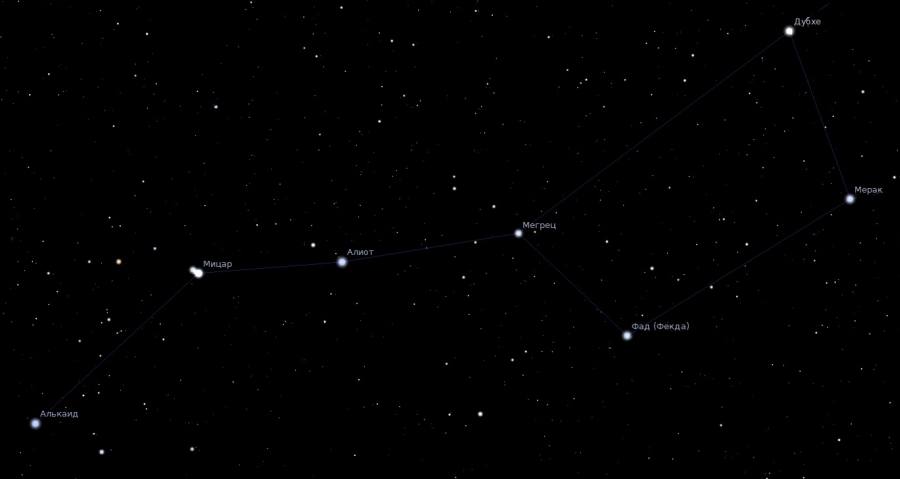
"Bucket" Big Dipper
The Big Dipper consists of the following seven stars:

It is noteworthy that the asterism of the Big Dipper has another name - “Hearse and Mourners”. According to this view, the three stars form the mourners, headed by the leader (“Al-Qaed Banat Nash”), behind whom the burial stretchers move.
On average, the stars that make up the Big Dipper are located at a distance of 120 light years from Earth. These luminaries are not the brightest in our sky, their average magnitude is close to 2m. However, almost everyone will not be difficult to find them in the sky.
There is a so-called moving group of the Big Dipper, the core of which consists of 14 stars. 13 of them are in the constellation Ursa Major, and 5 - in the Big Dipper (Merak, Fekda, Megrets, Aliot and Mizar). Unlike stars of this group, moving at close speeds in one direction, the other two Bucket stars (Dubhe and Benetnach) move in the other direction, as a result of which the shape of the Big Bucket undergoes a noticeable deformation over 100,000 years.
It is worth saying that in 2009 a new study revealed that, in fact, Mizar and Alcor is a six-fold system, where the double luminaries Mizar A and B rotate around the double star Alcor. No wonder, they are often born in pairs and in clusters.

Other objects of the Big Dipper
In addition to the Big Dipper, in the constellation Ursa Major you can also see asterism called “Three jumps of gazelles”, which looks like three pairs of stars. These are the following pairs:
- Alula North South (ν and ξ),
- Tania North and South (λ and μ),
- Talita North and South (ι and κ).
Near Alupu North there is a red dwarf called Lalande 21185, which is elusive for observation with the naked eye. However, it is the sixth nearest star system to the Sun. Closer stars Sirius A and B.
Fans of observational astronomy are well aware that in this constellation is the galaxy M101 (called the Pinwheel), as well as the galaxies M81 and M82. The latter two form the core, probably of the closest group of galaxies, located at a distance of about 7 million light years. Unlike these distant objects, the astronomical body of M-97 (“Owl”) is located within the Milky Way, hundreds of times closer. "Owl" is one of the largest planetary nebulae.
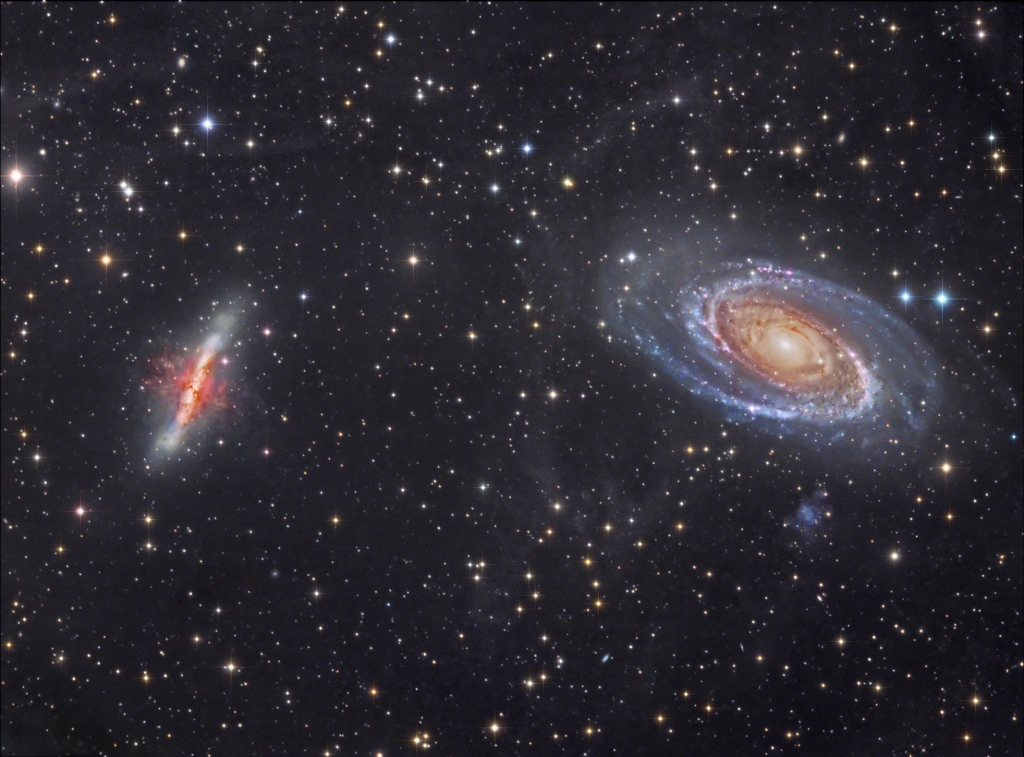
In the middle, between the first and second gazelle jumps, with the help of optics, you can notice a small yellow dwarf, similar to our Sun at number 47. From 2000 to 2010, scientists discovered three exoplanets, gas giants revolving around it. Also, this star system is one of the most similar to the Solar System and occupies the 72nd place in the list of candidates for the search for planets similar to Earth, conducted as part of the planned NASA Terrestrial Planet Finder mission. So for a lover of astronomy, the constellation is of great interest.
In 2013 and 2016, two of the most distant galaxies, z8 GND 5296 and GN-z11, were discovered in the constellation. The light of these galaxies, recorded by scientists, was 13.02 (z8 GND 5296) and 13.4 (GN-z11) billion years.
Among non-astronomical facts, it is worth noting that the Big Dipper is depicted on the flag of White Sea Karelia, and on the flag of Alaska - along with a polar star.

Flag of Alaska (left) and White Sea Karelia (right)
| List of constellations of the spring sky | |
|---|---|
| · · · | |
Constellations Ursa Major and Ursa Minor over the volcanic lagoon on the Canary Islands.
Photographer Juan Carlos Casado
The Great Bear is a large and bright constellation, the seven stars of which form the famous Big Dipper. This asterism - a bright group of stars - has been known since antiquity among many peoples, who, following their beliefs and ideas about the world, gave it their name and composed legends about it. In ancient Russia this constellation was called Woz, Chariot, Bucket; the peoples who inhabited the territory of Ukraine called it the Cart; in the Trans-Volga region, it was called the Big Bucket, and in the Russian North - “Elk”.
Among the nomads of the Kazakhs, the constellation was called “Seven robbers” who wanted to steal horses, and the Bashkirs called “Seven girls” who escaped from captivity and drowned in the lake.
And still in some areas these names have been preserved.
Representation of Gilgamesh, the king-hero from the city of Uruk, battling the "bull of heavens"; terracotta relief kept at the Royal Museums of Art and History, Brussels 2250–1900 BC
Schumer
Sumer-Akkadian and Babylonian astronomers observed the sky from the observatory towers that were placed in ziggurats. They compiled a number of astronomical tables, including a list dating back to the 5th century BC. e., which is a systematic review of the relative positions of the constellations. One of the most revered was "Great Carriage" - the constellation Ursa Major and "Anu Carriage" - Ursa Minor. These constellations are guides to the house where God dwells. It is located in the center, around which all the stars revolve.
Among the constellations there are prototypes of all the Babylonian cities: Sippara - in the constellation of Cancer, Nineveh - in the Great Bear, Ashshura - on Arcturus. The clay tablets tell of how King Sennacherib ordered to build Nineveh, famous for his libraries, according to "the project made on the basis of the heavenly design." Here the principle of “what is above is below” is traced.
From the Epic of Gilgamesh, the ruler of the Sumerian city of Uruk, it becomes known about the constellation of the "Heavenly Bull", which reveals the meaning of the asterism of the Great Dipper. The Sumerians, as the Greeks did later, saw only half a bull in the sky.
The constellation of Taurus - "Heavenly Bull"
The Sumerian hero of the epic Gilgamesh rejected the love of the goddess Ishtar and she sent the monstrous celestial bull Gugalanna on him. Gilgamesh killed the bull along with his comrade Enkida, who then tore off and threw the bull’s back leg into the face of the goddess. Therefore, only the front of the bull appeared in the sky.
Ishtar cried bitterly with the mourners, climbing the high walls of Uruk, and then descended to the underworld to see the burial of the celestial bull Gugalanna. And Enkidu died 12 days after the decision of the gods.
With Nergal, the god of the underworld, the “star that stands on the cart's cart” is identified - the scale of the Big Dipper, Alcor. She is also associated with the god of war and disaster.
Egypt. Bull thigh
The North Star and its environs were considered by the Egyptians to be a "fixed sky", a dwelling place of the gods. Instead of the bucket, the priests saw the leg of Set, the god of war and death, who turned into a bull and killed Osiris with a kick of the hoof. Falconry Horus cut off his limb in retaliation for the murder of his father.
The ancient Egyptians depicted constellations on the ceilings of temples and tombs.
The Big Dipper constellation is depicted as Bull's Thigh in the second largest temple of ancient Egypt - the temple of Edfu. In the ancient Egyptian zodiacs, the goddess Taurt (Tauret, Tauris), symbolizing the Big Dipper, is holding a sword, which is a stylized image of the seven-star Ursa Major bucket. According to myths, the goddess Thaurt cut off the past time with this sword - centuries, millennia, eras, eras, cycles.
The knowledge of the Egyptians was borrowed by the Arabs, and then the Greeks. All Bucket stars have their own Arabic names: Merak (β) - “loin”; Thekda (γ) - "thigh"; Megretz (δ) - "the beginning of the tail"; Aliot (ε) - "rump"; Mizar (ζ) - "sash" or "loincloth".
The last star in the bucket handle is called Benetnash or Alkaid, which in Arabic means "leader of mourners."
Thus, the Arabs also represented a constellation in the form of the Hearse and the Mourners: in front of the mourners, headed by the leader, followed by burial stretchers.
China. The Emperor's Carriage
In ancient China, the Great Bucket was called the Dow constellation, the Chariot of the Heavenly Emperor, which moves in the very center and controls the four sides of the heavens. Inside the bucket on the platform sits a figure, under the platform, a serpent coiled into a ring (like four wheels), and on the right a horse pulling a two-wheeled chariot.
India. Seven Wise Men
The Hindus also attached great importance to the Polar Star, which, according to the experts of the Vedas, is the abode of Vishnu himself. The Bucket’s asterism located under it was considered Saptarish — the seven wise men who were born from the mind of Brahma, the forefathers of the world of our age (Kali-yuga) and all who live in it.
Greece. Dipper
The Great Bear is one of the 48 constellations listed in the star catalog of Ptolemy around 140 BC.
The Greek myth tells that Zeus turned the beautiful nymph Callisto into a Bear, in order to save her from revenge on his jealous wife Hera. Knowing how much Callisto was tied to her maid, Zeus and her ascended to heaven and left there in the form of a small but beautiful constellation Ursa Minor.
America. Great Bear
In the Iroquois legend about the origin of asterism, the three stars that form the bucket handle are three hunters stalking the beast: Aliot pulls a bow with an arrow nested in it, Mizar carries a meat cooking pot (Alcor), and Benetnash has an armful of scrub to ignite the hearth. In the fall, when the Bucket turns and falls low to the horizon, blood from a wounded bear drips down, painting the trees in motley colors.
New Articles
- What is the highest peak of the Ural Mountains
- The most ancient religions in the world
- What continents are washed by the Atlantic Ocean?
- Can I wear jewelry of the deceased?
- Snake, Bowl and Staff: The Origin of Medical Symbols
- Interesting facts about hares
- Names of famous brands in other countries
- Karelo Finnish epic kalevala protagonists
- 17 18 weeks pregnant sensations
- Why do people become so aggressive
Popular articles
- Expression twice in one river, meaning and meaning
- Gusli - musical instruments
- Report: Temperature Scales and Thermometers
- Which side to sew on chevron
- How to draw emblems for school
- Unusual rivers of the world and the rivers of Russia - Rivers with sour water
- Numb of the little finger on the right hand: causes and methods of treatment
- Why development is important for a person
- Constellations from ancient atlases
- What happens at 31 weeks
